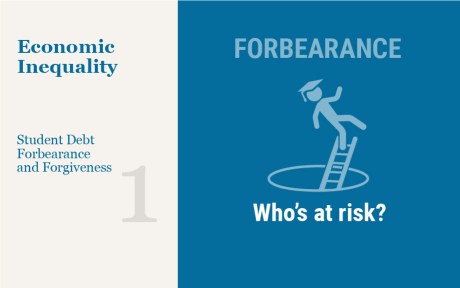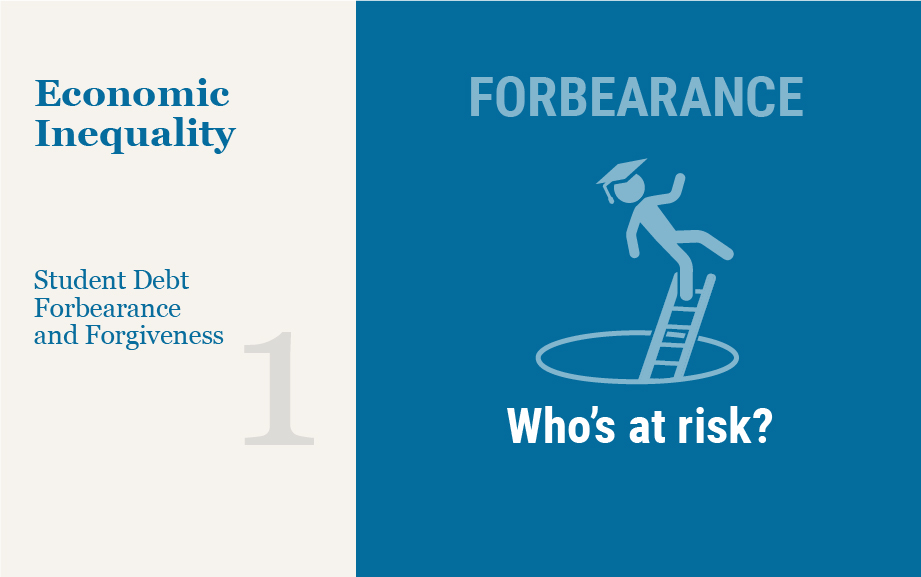
Federal student loan relief was recently extended through August 31, 2022, marking the sixth extension during the pandemic. Such debt relief includes the suspension of student loan payments, a waiver of interest, and the stopping of collections activity on defaulted loans. The suspension of student loan payments was expected to help 41 million borrowers save an estimated $5 billion per month. This post is the first in a two-part series exploring the implications and distributional consequences of policies that aim to address the student debt burden. Here, we focus on the uneven consequences of student debt relief and its withdrawal. With the end-date of the student loan relief drawing near, a key question is whether and how the discontinuation of student debt relief might affect households. Moreover, will these effects vary by demographics?
Student debt forbearance relief during the pandemic has been instrumental in staving off student loan delinquencies and defaults, which previous research has linked to delays in homebuying and other measures of financial stress. Private student loans are not eligible for this relief while most federal student loans are. Exceptions are certain FFEL, Perkins and HEAL loans. Will delinquency rates climb to pre-pandemic levels as student debt relief ends? Using data collected from student loan borrowers in the New York Fed’s Survey of Consumer Expectations, we seek to understand who obtained student loan forbearance relief, who continues to be in forbearance, and what do they expect to happen if the relief were to end. The second post in this series explores the demographic differences of alternative student debt forgiveness policies.
Insight from the Survey of Consumer Expectations
In this post, we leverage data from the May 2021 Survey of Consumer Expectations (SCE). In May 2021, federal student loan borrowers were also eligible for forbearance relief and it was set to expire on September 30 of that year. Currently, the student loan borrowers face a similar situation, with student loan forbearance expected to end at the end of August 2022. From this perspective, we hypothesize that the survey responses on expectations of future repayment and delinquencies can shed light on current expectations about future repayment and delinquencies. Since June 2013, this monthly survey has collected information on the economic expectations, choices, and behavior of household heads. The SCE covers about 1,300 nationally representative U.S. households and, in addition to monthly core questions, special modules focusing on specific topics are fielded frequently.
Here, we use data collected both as part of the May 2021 core survey as well as from a special module in that month that focused on debt relief during the pandemic. As part of the special module, we asked respondents about debt repayment, receipt of debt relief, the type of relief received, and their expectations that they will miss a debt payment in the next three months. Additionally, we asked respondents to consider a counterfactual scenario under which student debt relief is discontinued forthwith and elicited their expectation that they will miss a payment in the next three months under this scenario.
Student Debt and Likelihood of Any Missed Debt Payment
We begin by investigating households’ expected likelihood of missing any debt payment (that is, any of the minimum required payments on credit and retail cards, auto loans, student loans, mortgages, or any other debt) in the next three months. The average probability of missing a payment is 9.7 percent for the 1,232 households that answered this question. Student debt holders expected a 13.5 percent chance of missing a minimum debt payment in comparison to 8.7 percent for those who did not have student debt. Thus, even with most having an automatic pause on their student debt payments and thereby avoiding delinquency on such loans, student loan borrowers perceived a higher risk of missing a minimum required payment on other outstanding debts. This is consistent with the lower average age, income, and credit score of student loan borrowers—a difference that existed even before the pandemic. These groups are the ones that experienced the greatest financial hardship during the pandemic, with younger workers disproportionally working in the hardest hit sectors of the economy, seeing larger increases in their unemployment rate, and a lower share of younger workers being eligible for unemployment insurance expansions.
Student debt holders who had an income-driven repayment (IDR) plan were less likely to expect that they will be delinquent in the next three months (13.0 percent versus 14.6 percent) on any debt payment. Thus, we find that student debt holding is associated with a higher perceived probability of delinquency while having an IDR plan reduces this risk, likely by restricting payment to a relatively manageable share of their income.
Focusing on borrowers who reported receiving some type of debt relief (other than student debt relief) during the pandemic, we investigate whether such “ever-relief borrowers” had a different perceived risk of being past due on a loan in the near future. We find that debt relief recipients (those receiving fee and interest waivers, debt forgiveness, or a deferral or delay on credit card, auto loan, or mortgage payments) are more likely to expect that they will be delinquent, with an average probability of missing a payment of 23.2 percent compared to 7.8 percent for those who never received debt relief. This suggests that borrowers who received temporary relief are financially worse off and more likely to have needed the financial support. They remain financially more vulnerable and expect a higher level of financial insecurity in the future.
Although Debt Relief Recipients Perceived a Higher Likelihood of Delinquency; Those with IDR Perceived a Lower Likelihood of Such Distress
| Average percent chance of not being able to make a debt payment in the next three months | |
|---|---|
| Overall | 9.7 |
| No Student Loan | 8.7 |
| Student Loan | 13.5 |
| No IDR | 14.6 |
| IDR | 13 |
| Never Debt Relief (except student loan) | 7.8 |
| Ever Debt Relief (except student loan) | 23.2 |
| Observations | 1232 |
Note. “Ever Debt Relief” refers to borrowers who have ever obtained debt relief (other than for student loans) during the pandemic. “Never debt relief” refers to borrowers who never obtained such relief.
We next focus our attention on borrowers who received student loan forbearance. The first column in the table below focuses on the 159 borrowers in our sample who have ever received student debt forbearance through the administrative forbearance of federal student loans. On average, these borrowers expect an 11.8 percent likelihood of missing any debt payment in the next three months, slightly smaller than the likelihood faced by an average student loan borrower (13.5 percent). Note that this contrasts with the finding from the above table where borrowers with other kinds of debt relief expected a higher probability of delinquency than those who did not seek and obtained relief. This difference can be explained by two factors. First, borrowers with federal student debt automatically entered forbearance whereas borrowers with other debt sought out relief, likely when they were financially more vulnerable. Second, federal student debt holders who never received forbearance mostly hold FFEL and Perkins loans which were associated with higher delinquencies during this period.
Among borrowers who have ever received student loan forbearance, there is considerable heterogeneity in perceived future delinquency risk by demographics as well as IDR status. We find that less educated, lower-income, female, non-white and middle-aged borrowers expect a higher risk of such delinquency. Consistent with the finding above, we find that borrowers who do not have an IDR plan perceive a higher likelihood of financial distress (as captured by delinquency).
The second column of the table below focuses on the 116 borrowers who in May 2021 remained in student loan forbearance. Borrowers who remained in forbearance have a slightly higher expected delinquency rate than those who ever received forbearance (12.9 percent versus 11.8 percent), although this difference is only marginally statistically significant. Differentiating by demographics, we find the same patterns as above, except that average delinquency probabilities generally are somewhat higher. These results go beyond our earlier findings indicating that student loan borrowers who availed themselves of the option and continue to remain in forbearance perceive a significant risk of missing a debt payment over the next three months, even after pausing their student loan payment and able to continue doing so over the next three months.
Among Forborne Borrowers, Less Educated, Women, and Racial Minority Borrowers Have Higher Expected Delinquency Rates as Do Those Without an IDR
| Ever Received Student Loan Forbearance | Currently in Forbearance | |
|---|---|---|
| Overall | 11.8 | 12.9* |
| No College | 17.2 | 19.2* |
| College | 8.1 | 7.8 |
| <60k (US dollars) | 13.7 | 15.1* |
| >60k (US dollars) | 10.9 | 11.6 |
| Male | 10.2 | 11.4* |
| Female | 12.7 | 13.8 |
| Non-white | 15.3 | 17.2* |
| White | 10.8 | 11.4 |
| <40 yrs old | 9.9 | 10.7 |
| 41-60 yrs old | 15.9 | 17.7* |
| >60 yrs old | 2.6 | 2.6 |
| No IDR | 13.3 | 14.5 |
| IDR | 9.5 | 10.5 |
| Observations | 159 | 116 |
Stars denote whether column 2 is statistically different from column 1. * p<0.1, ** p<0.05,
*** p<0.01
Finally, we conduct a hypothetical exercise where we ask respondents who continue to avail themselves of student debt forbearance to consider a scenario in which all student debt forbearance is discontinued at the end of the month. Then we asked respondents about their expected likelihood of student loan delinquency in the next three months. We find that, under this scenario the borrowers expect a 16.1 percent risk of delinquency on their student debt. Differentiating by demographics, we find that lower-income, less educated, non-white and female borrowers expect a higher likelihood of delinquency, should the relief be discontinued. Consistent with the above results, discontinuation of student debt forbearance will more adversely affect borrowers without an IDR plan with an almost 50 percent higher expected delinquency rate compared to those who do.
Discontinuation of Student Debt Relief Will Hit the Less Educated, Women, Racial Minorities, and Middle-Aged Borrowers the Hardest.
| Currently in Forbearance | |
|---|---|
| Overall | 16.1 |
| No College | 18.7 |
| College | 14.1 |
| <60k (US dollars) | 18.7 |
| >60k (US dollars) | 14.7 |
| Male | 8.3 |
| Female | 21.5 |
| Non-white | 13.6 |
| White | 17 |
| <40 yrs old | 13.1 |
| 41-60 yrs old | 21.5 |
| >60 yrs old | 11.9 |
| No IDR | 16.5 |
| IDR | 15.7 |
| Observations | 116 |
Note: Sample of student debt borrowers who are in administrative forbearance.
Our analysis suggests that the scheduled discontinuation of student debt forbearance on August 31 will likely increase financial hardship and delinquency rates. Borrowers currently availing themselves of student debt forbearance expect a 16 percent chance of delinquency if relief is discontinued. Assuming a zero-delinquency rate among those not currently receiving student debt relief, this suggests an overall borrower delinquency rate of 10 percent, a return to two-thirds of the pre-pandemic student loan delinquency rate of 15.6 percent of borrowers. Our 10 percent estimate is clearly a lower bound as we have assumed that those that are not currently in forbearance have a zero percent expected delinquency rate, thus implying that we cannot rule out that the delinquency rate at relief withdrawal could reach or even surpass the pre-pandemic rate.
We also find that this hardship in repayments will not affect all borrowers evenly. Rather, we find that lower-income, less educated, non-white, female and middle-aged borrowers will struggle more in making minimum payments and in remaining current. Borrowers who do not have an IDR plan are expected to be relatively worse off, likely because the IDR allows payments to be more manageable amid income fluctuations. Finally, our analysis suggests likely consequences for repayment of debts other than student loans, with student loan borrowers reporting high average risks of delinquency on other debts even while their student loan payments were paused.


Jessica Lu is a senior research analyst in Bank’s Research and Statistics Group.



